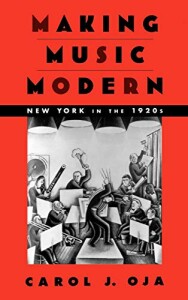 The 1920s was a formative decade for “serious” American music, and the nexus of musical activity was in New York. Music professor Carol Oja provides an in-depth exploration of the music of the decade and its continuing impact on American music through the present day, in this lucid book.
The 1920s was a formative decade for “serious” American music, and the nexus of musical activity was in New York. Music professor Carol Oja provides an in-depth exploration of the music of the decade and its continuing impact on American music through the present day, in this lucid book.
What a treasure trove of history, sociology and musical insight this book is. Anyone seriously interested in a study of American music should have it at hand. It’s not light reading, or a popular history, but Oja’s writing style is so concise and reader-friendly that anyone with an interest in the subject should find it accessible.
At the beginning of the book and of each chapter, Oja clearly lays out her theme, then goes on to flesh it out with more-than-adequate examples, gleaned from a prodigious amount of research. Her opinions are always backed up by facts and figures, but, thankfully, she doesn’t just dump reams of research on the reader, but instead interprets it skillfully.
Oja herself gives the best overview of the book in her introduction:
I have aimed for neither a chronological survey nor comprehensive coverage, and I adhere to no single method of musical analysis. Rather, I situate new concert music within what the composer Marc Blitzstein once called ‘the economic, spiritual, ethnic, and esthetic facts of our time.’
So not only is the book chock-full of history, analysis and commentary, but it’s also well organized.
Making Music Modern examines the lives, times and music of nearly all of the influential American-born or immigrant modernist composers of the early 20th Century: Leo Ornstein, Edgard Varese, Dane Rudhyar, Carl Ruggles, Renry Cowell and Ruth Crawford. She also includes some of those less-well-known today, such as Marion Bauer, Frederick Jacobi, Emerson Whithorne and Louis Gruenberg. She gives much ink to neoclassicism — its origins and the controversies surrounding the movement, as well as in-depth examinations of the major neoclassical composers: Copland, Virgil Thomson and others. Also examined is the uneasy relationship between concert music and jazz, particularly the kind of serious crossover works composed by Gershwin, Paul Whiteman, William Grant Still and others. And she discusses the spiritual, religious, social and political background that underlay the birth of modernism and dissonance.
Oja has chosen musical works by these composers that are not among their best known, but which she feels are representative of each composer’s works, particularly in relation to modernism. Included in the discussion of the pieces are photocopies of one or more pages of the actual sheet music, valuable artifacts in themselves.
In addition to the composers and their music, Oja also looks at the key roles played by some critics, various musicians’ and composers’ societies and collectives, influential concert series, and the contributions of several female patrons of the arts. And, finally, Oja is careful to continually examine the constantly changing relationship between American and European modernism, puncturing some myths along the way.
Among the valuable appendices are a selected discography of CDs of the pieces discussed in the book, and an exhaustive listing of performances, by composer, during the decade.
Making Music Modern is a priceless resource for anyone interested in serious American music. It’s deserving of the awards it has already won.
Learn more at the Oxford University Press website.
(Oxford University Press, 2003)
